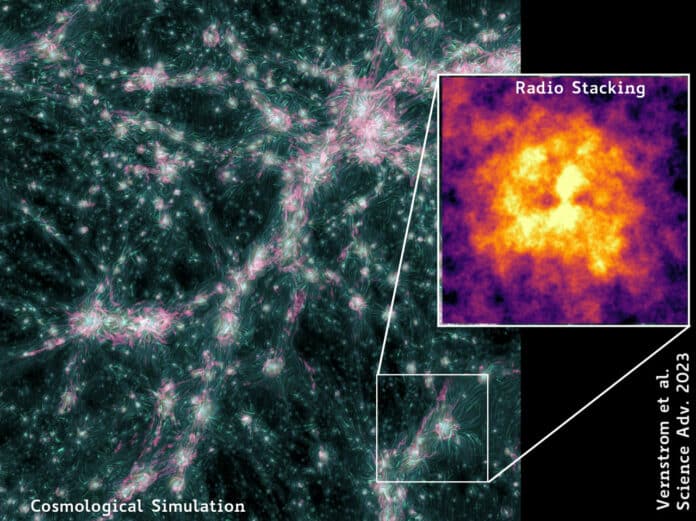Scientists have found evidence of magnetic fields in the cosmic web of the universe.
Polarised shockwaves shake the universe’s cosmic web.
The large-scale structure of the Universe is composed of clusters, filaments, and voids, collectively known as the cosmic web. This structure is formed through the anisotropic gravitational collapse of matter from primordial overdensities in the Λ cold dark matter (ΛCDM) cosmology. The cosmic web has been mapped through observation over the past few decades, offering new possibilities for addressing some of astronomy’s most pressing questions.

One such area of interest is the behavior of magnetic fields on a cosmic scale and their role in the formation of galactic and cosmic structures. Scientists from ICRAR have recently discovered compelling evidence of magnetic fields in the universe’s most significant cosmic structures.
Dr. Tessa Vernstrom from The University of Western Australia’s (UWA) node of ICRAR said, “Magnetic fields pervade the universe – from planets and stars to the largest spaces in-between galaxies. However, many aspects of cosmic magnetism are not yet fully understood, especially at the scales seen in the cosmic web.”
“When matter merges in the universe, it produces a shockwave which accelerates particles, amplifying these intergalactic magnetic fields.”
By recording radio emissions from the cosmic web, the study captured the first observational evidence of strong shockwaves, previously only seen in the largest galaxy clusters in the universe. This event was believed to be the “signature” of matter collisions occurring throughout the cosmic web.
Dr. Vernstrom said, “These shockwaves give off radio emissions which should result in the cosmic web ‘glowing’ in the radio spectrum, but it had never been conclusively detected due to how faint the signals are.”
Dr. Vernstrom’s team began searching for the “radio glow” of the cosmic web in 2020 and detected signals that potentially originated from these cosmic shockwaves. They selected polarised radio light as a signal type due to its lower background “noise,” as the initial transmissions may have included emissions from galaxies and other astronomical objects in addition to the shockwaves.
However, Vernstrom chose a different signal type with less background “noise” — polarised radio light — as these first signals might have contained emissions from galaxies and astronomical objects other than the shockwaves.
Vernstrom said, “As very few sources emit polarised radio light, our search was less prone to contamination, and we have been able to provide much stronger evidence that we are seeing emissions from the shockwaves in the largest structures in the universe, which helps to confirm our models for the growth of this large-scale structure.”
In order to conduct their study, the scientists utilized data and all-sky radio maps obtained from various sources, including the Global Magneto-Ionic Medium Survey, the Planck Legacy Archive, the Owens Valley Long Wavelength Array, and the Murchison Widefield Array. They employed a stacking technique to enhance the weak signal above the background noise of the images, which was then compared to sophisticated cosmological simulations created through the Enzo Project.
The simulations were the first to incorporate forecasts of the polarized radio light from the cosmic shockwaves identified in this study.
Journal Reference:
Tessa Vernstrom et al. Polarized accretion shocks from the cosmic web. Science Advances. DOI: 10.1126/sciadv.ade7233



I always spent my half an hour to read this website’s content daily along with a cup of
coffee.